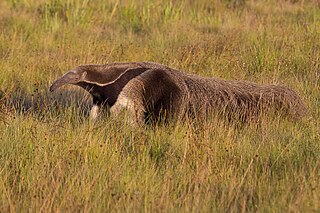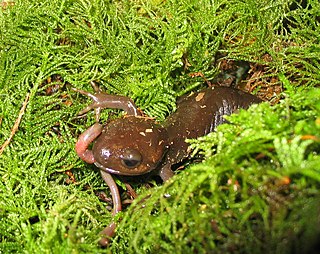Related Research Articles

A definition is a statement of the meaning of a term. Definitions can be classified into two large categories: intensional definitions, and extensional definitions. Another important category of definitions is the class of ostensive definitions, which convey the meaning of a term by pointing out examples. A term may have many different senses and multiple meanings, and thus require multiple definitions.

Genus is a taxonomic rank above species and below family as used in the biological classification of living and fossil organisms as well as viruses. In binomial nomenclature, the genus name forms the first part of the binomial species name for each species within the genus.

In taxonomy, binomial nomenclature, also called binary nomenclature, is a formal system of naming species of living things by giving each a name composed of two parts, both of which use Latin grammatical forms, although they can be based on words from other languages. Such a name is called a binomial name, a binomen, binominal name, or a scientific name; more informally it is also historically called a Latin name. In the International Code of Zoological Nomenclature (ICZN), the system is also called binominal nomenclature, with an "n" before the "al" in "binominal", which is not a typographic error, meaning "two-name naming system".

Echidnas, sometimes known as spiny anteaters, are quill-covered monotremes belonging to the family Tachyglossidae, living in Australia and New Guinea. The four extant species of echidnas and the platypus are the only living mammals that lay eggs and the only surviving members of the order Monotremata. The diet of some species consists of ants and termites, but they are not closely related to the American true anteaters or to hedgehogs. Their young are called puggles.

The International Code of Zoological Nomenclature (ICZN) is a widely accepted convention in zoology that rules the formal scientific naming of organisms treated as animals. It is also informally known as the ICZN Code, for its publisher, the International Commission on Zoological Nomenclature. The rules principally regulate:

Johann Georg Wagler was a German herpetologist and ornithologist.

Peter Forsskål, sometimes spelled Pehr Forsskål, Peter Forskaol, Petrus Forskål or Pehr Forsskåhl was a Swedish-speaking Finnish explorer, orientalist, naturalist, and an apostle of Carl Linnaeus.

Systema Naturae is one of the major works of the Swedish botanist, zoologist and physician Carl Linnaeus (1707–1778) and introduced the Linnaean taxonomy. Although the system, now known as binomial nomenclature, was partially developed by the Bauhin brothers, Gaspard and Johann, Linnaeus was the first to use it consistently throughout his book. The first edition was published in 1735. The full title of the 10th edition (1758), which was the most important one, was Systema naturæ per regna tria naturæ, secundum classes, ordines, genera, species, cum characteribus, differentiis, synonymis, locis, which appeared in English in 1806 with the title: "A General System of Nature, Through the Three Grand Kingdoms of Animals, Vegetables, and Minerals, Systematically Divided Into their Several Classes, Orders, Genera, Species, and Varieties, with their Habitations, Manners, Economy, Structure and Peculiarities".

Fruitafossor was a termite-eating mammal endemic to North America during the Late Jurassic epoch.

The short-beaked echidna, also called the short-nosed echidna, is one of four living species of echidna, and the only member of the genus Tachyglossus. It is covered in fur and spines and has a distinctive snout and a specialised tongue, which it uses to catch its insect prey at a great speed. Like the other extant monotremes, the short-beaked echidna lays eggs; the monotremes are the only living group of mammals to do so.
In botanical nomenclature, author citation is the way of citing the person or group of people who validly published a botanical name, i.e. who first published the name while fulfilling the formal requirements as specified by the International Code of Nomenclature for algae, fungi, and plants (ICN). In cases where a species is no longer in its original generic placement, both the authority for the original genus placement and that for the new combination are given.
In zoological nomenclature, the valid name of a taxon is the correct scientific name for that taxon. The valid name must be used for that taxon, regardless of any other name that may currently be used for that taxon, or may previously have been used. A name can only be valid when it is an available name under the International Code of Zoological Nomenclature (ICZN); if a name is unavailable, then it cannot be considered either valid or invalid.
In biology, a homonym is a name for a taxon that is identical in spelling to another such name, that belongs to a different taxon.

A conserved name or nomen conservandum is a scientific name that has specific nomenclatural protection. That is, the name is retained, even though it violates one or more rules which would otherwise prevent it from being legitimate. Nomen conservandum is a Latin term, meaning "a name to be conserved". The terms are often used interchangeably, such as by the International Code of Nomenclature for Algae, Fungi, and Plants (ICN), while the International Code of Zoological Nomenclature favours the term "conserved name".

Priority in biology is a taxonomic principle by which a valid scientific name is established based on the oldest available name. It is a decisive rule in botanical and zoological nomenclature to recognise the first binomial given to an organism as the correct and acceptable name. The purpose is to select one scientific name as a stable one out of two or more alternate names that often exist for a single species. The International Code of Nomenclature for algae, fungi, and plants (ICN) defines it as: "A right to precedence established by the date of valid publication of a legitimate name or of an earlier homonym, or by the date of designation of a type."
In biodiversity informatics, a chresonym is the cited use of a taxon name, usually a species name, within a publication. The term is derived from the Greek χρῆσις chresis meaning "a use" and refers to published usage of a name.

Anteaters are the four extant mammal species in the suborder Vermilingua, commonly known for eating ants and termites. The individual species have other names in English and other languages. Together with sloths, they are within the order Pilosa. The name "anteater" is also commonly applied to the aardvark, numbat, echidnas, and pangolins, although they are not closely related to them.

Vermivore is a zoological term for animals that eat worms. Animals with such a diet are known to be vermivorous. Some definitions are less exclusive with respect to the diet, but limit the definition to particular animals, e.g. "Feeding on worms or insect vermin. Used of a bird."

This is a list of terms and symbols used in scientific names for organisms, and in describing the names. For proper parts of the names themselves, see List of Latin and Greek words commonly used in systematic names. Note that many of the abbreviations are used with or without a stop.

Yinotheria is a proposed basal subclass clade of crown mammals uniting the Shuotheriidae, an extinct group of mammals from the Jurassic of Eurasia, with Australosphenida, a group of mammals known from the Jurassic to Cretaceous of Gondwana, which possibly include living monotremes. Today, there are only five surviving species of monotremes which live in Australia and New Guinea, consisting of the platypus and four species of echidna. Fossils of yinotheres have been found in Britain, China, Russia, Madagascar and Argentina. Contrary to other known crown mammals, they retained postdentary bones as shown by the presence of a postdentary trough. The extant members (monotremes) developed the mammalian middle ear independently.